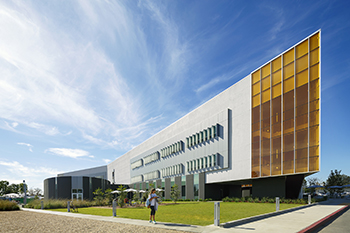Mid-Century Designs Influence Orange Coast’s Interdisciplinary Complex
 COSTA MESA, Calif. — Orange Coast College in Costa Mesa, recently debuted a new Interdisciplinary Complex (IDC), designed to incorporate mid-century design techniques from the original surrounding campus. The 91,037-square-foot, three-story building houses classrooms, labs and faculty offices for the college’s Mathematics, Business and Computing programs.
COSTA MESA, Calif. — Orange Coast College in Costa Mesa, recently debuted a new Interdisciplinary Complex (IDC), designed to incorporate mid-century design techniques from the original surrounding campus. The 91,037-square-foot, three-story building houses classrooms, labs and faculty offices for the college’s Mathematics, Business and Computing programs.
School Construction News spoke with Franco Brown, associate, design director at LPA Inc. in the architecture firm’s Higher Education Group, about how the company incorporated circa-1950s design elements into the new complex.
Q: What are some of the project’s key design elements?
Brown: The building design was inspired by the biorealism concepts first introduced by mid-century master architect Richard Neutra. Along with his then-partner Robert Alexander, Neutra designed many of the original campus buildings as long, linear bars that blurred the lines between indoor and outdoor space, integrating nature and using operable windows for natural ventilation. After 60 years, his ideas still hold true today. We designed the building as a long and narrow ‘bar’ (clad in orange glass) that folds on itself to create an internal student courtyard. This bar (that houses the majority of the classrooms) was elevated over a concrete podium to capture natural light and the nearby ocean breezes. The featured lecture and specialty labs as well as the faculty offices were located on the ground floor for easy wayfinding and accessibility. The circular Computing Center was created using a radial array to allow staff to monitor six different spaces and the central computer floor from one location.
Q: What green building elements were integrated into the facility?
Brown: The single-loaded exterior circulation of the upper level bars gives each classroom space access to cross ventilation and natural light on two sides. This model challenges the notion that everyday work and study spaces must be enclosed in air-conditioned boxes and disconnected from the outdoors. While the building still provides air-conditioning when needed (an electronic signal is sent to the equipment when windows open), it leverages the Southern California climate using natural ventilation for many months of the year, reducing energy costs and enhancing the indoor experience.
Additionally, the majority of the building’s circulation areas (hallways, corridors, lobbies and social spaces) were designed as protected exterior spaces that do not need air-conditioning, reducing the energy load of those systems by more than 25 percent. The roofs on the concrete podium were originally designed as elevated gardens to capture and collect rainwater. The concept was later changed, replacing the vegetation by pebble ballast and cacti.
Q: How have the staff and faculty influenced the design?
 Brown: The staff and faculty’s main concern at the beginning of the design process was the assumption that five different academic programs would be housed under one roof. This mega-building concept would make wayfinding and identity for each program very difficult. LPA’s design response was to give each program a dedicated bar that could be easily identifiable by color and material and phased over time. The bars (five in total) would bend and fold, creating courtyards and landscaping between them. The IDC project establishes the first phase with two bars housing the Mathematics and Business programs. Phase II will see an additional three bars built for Social Sciences, Literature and Languages.
Brown: The staff and faculty’s main concern at the beginning of the design process was the assumption that five different academic programs would be housed under one roof. This mega-building concept would make wayfinding and identity for each program very difficult. LPA’s design response was to give each program a dedicated bar that could be easily identifiable by color and material and phased over time. The bars (five in total) would bend and fold, creating courtyards and landscaping between them. The IDC project establishes the first phase with two bars housing the Mathematics and Business programs. Phase II will see an additional three bars built for Social Sciences, Literature and Languages.
Q: How is this project different from those you’ve completed in the past?
Brown: The project achieves full integration with its context and natural environment. The building’s orientation, and its unusual and iconic shape is the direct result of the programmatic needs as well as the desire to leverage the local climate to enrich the lives of students, faculty and staff.
